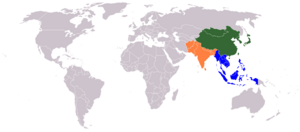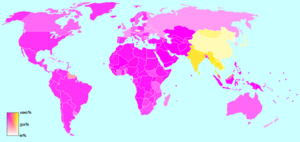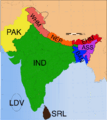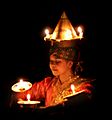Eastern world facts for kids
The Eastern world is a big term for many different cultures and ways of life in Asia. It includes places like the Indian subcontinent (such as India, Pakistan, and Bangladesh) and the Far East (like China, Japan, and South Korea). Sometimes, Australasia (Australia and New Zealand) is also included. The Middle East and Central Asia are often seen as part of the "East" too.
Contents
Understanding the Eastern World

The idea of "East" and "West" comes from European history. It shows a difference between European Christendom and other cultures to its East. When Europeans explored the Americas, this East/West idea became global.
The "East" was often called "Oriental." People thought of it as different in terms of race, religion, and culture. Western scholars studied these differences in fields like Orientalism. During the Cold War, "Eastern world" sometimes meant the Soviet Union and its communist allies. The "Western world" then meant the United States and its allies like the United Kingdom.
The term "Eastern world" often refers to the Far East. This region shares many cultural and religious ideas. Eastern philosophy, art, and literature are very important there. The spread of Buddhism and Hindu Yoga helped connect these areas.
Eastern Cultures and Traditions


Eastern culture has many important themes and traditions. These include different religions, philosophies, and types of medicine.
Eastern Religions and Philosophies
Many major religions and philosophies come from the East.
Far Eastern Religions
- Confucianism: This belief from China teaches that people can become better. This happens through self-improvement and community effort.
- Eastern Buddhism: A major form of Buddhism, widely practiced in East Asia.
- Shinto: The traditional religion of Japan, focusing on spirits called kami.
- Daoism: A Chinese philosophy that emphasizes living in harmony with nature.
Indian Religions
These religions started in the Indian subcontinent.
- Buddhism: A path to freedom from suffering. It teaches understanding the true nature of reality.
- Hinduism: A group of religious traditions native to India. It includes many different beliefs and practices.
- Jainism: An ancient Indian religion that teaches non-violence towards all living things.
- Sikhism: A religion from the Punjab area. Its followers value both spiritual and brave qualities.
Middle Eastern Religions
The Middle East is largely known as the Islamic world today.
- Christianity: This religion, like Judaism and Islam, began in the Middle East. It is now a smaller religion there.
- Islam: Most of the world's Muslim people live in Asia. Islam spread and became the main religion in many Asian areas.
- Judaism: This ancient religion still exists in Asia. You can find communities of Mizrahi Jews there.
- Zoroastrianism: An old religion from Sassanid Persia. It believes in one God.
Eastern Medicine
Many traditional medical practices come from the East.
- Ayurveda: An ancient healing system from India.
- Chinese medicine: A system of medicine developed in China over thousands of years.
- Kampo: A traditional Japanese medicine system.
- Traditional Tibetan medicine: A healing system from Tibet, influenced by Indian and Chinese medicine.
- Traditional Korean Medicine: A traditional healing system from Korea.
Images for kids
-
Dispersal of Austronesian languages
-
Mongolian Buuz
-
Kebabs are a popular cuisine among Middle Easterners.
-
Round challah, a special bread in Jewish cuisine
-
Sushi has become prevalent even among westerners.
-
Armenian khash (or pacha), which is also commonly eaten by Assyrians, Arabs and Kurds.
-
Ramoji Film City located in Hyderabad, holds the Guinness World Record for the World's largest film studio.
-
The Tian Tan Buddha statue in Hong Kong.
-
A Syro-Malabar Catholic bishop holding the Mar Thoma Christian Cross which symbolizes the heritage and identity of the Syrian Church of Saint Thomas Christians of India
-
The Monastery of St. Matthew, located atop Mount Alfaf in northern Iraq, is recognized as one of the oldest Christian monasteries in existence.
-
Assyrian Christians from lake Urmia in north eastern Persia in their traditional costumes.
-
Mor Hananyo Monastery is located in the Syriac cultural region known as Tur Abdin in Turkey.
-
Chaldean Catholic from the town of Alqosh, Iraq.
-
Temple of Confucius in Liuzhou, Guangxi.
-
The Druze Maqam Nabi Shu'ayb.
-
The Western Wall and Dome of the Rock in Jerusalem.
-
Aerial view of Masada, Israel
-
Great synagogue in Afula, Israel
-
Color drenched Gopis during the Holi celebrations in Krishna Temple, Mathura.




























